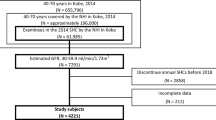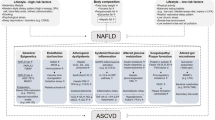Abstract
Objective
To evaluate the association between high uric acid (UA), reduced estimated glomerular filtration rate (eGFR), and non-alcoholic fatty liver disease (NAFLD) in outpatient children and adolescents with overweight (OW) or obesity (OB).
Methods
Anthropometric, biochemical, hepatic ultrasound and eGFR data were available from 2565 young people with OW/OB (age 5–18 years). eGFR was calculated using the Schwartz’s bedside formula and reduced eGFR (ReGFR+) was defined by a value < 90 mL/min/1.73 m2. High UA was defined as ≥ 75th percentile by sex in children and adolescents.
Results
The population was stratified in four categories: (1) normal eGFR and absence of NAFLD (ReGFR−/NAFLD−) (n = 1,236); (2) ReGFR+ and absence of NAFLD (ReGFR+/NAFLD− (n = 155); (3) normal eGFR and presence of NAFLD (ReGFR−/NAFLD+) (n = 1019); (4) presence of both conditions (ReGFR+/NAFLD+) (n = 155). Proportions of youth with high UA across the four categories were 17%, 30%, 33% and 46%, respectively (P < 0.0001). Young people with high levels of UA had odds ratio (95% CI) of 2.11 (1.43–3.11) for ReGFR+; 2.82 (2.26–3.45) for NAFLD+; and 5.04 (3.45–7.39) for both conditions (P < 0.0001 for all), independently of major confounders.
Conclusions
High levels of UA were independently associated with ReGFR, NAFLD and the combination of both conditions in young people with OW/OB. The strength of this association was the highest in cases presenting both reduced eGFR and NAFLD. UA may serve as marker to identify patients at risk for these conditions.

Similar content being viewed by others
Abbreviations
- ALT:
-
Alanine aminotransferase
- BMI:
-
Body mass index
- CARITALY:
-
CARdiometabolic risk factors in overweight and obese children in ITALY
- CKD:
-
Chronic kidney disease
- CVD:
-
Cardiovascular disease
- DBP:
-
Diastolic blood pressure
- ISPED:
-
Italian Society of Pediatric Endocrinology and Diabetology
- eGFR:
-
Estimated glomerular filtration rate
- HOMA-IR:
-
Homeostasis model assessment of insulin resistance
- NAFLD:
-
Non-alcoholic fatty liver disease
- OW:
-
Overweight
- OB:
-
Obesity
- OR:
-
Odds ratio
- SBP:
-
Systolic blood pressure
- TG/HDL:
-
Triglycerides-to-HDL cholesterol ratio
- UA:
-
Uric acid
- WHtR:
-
Waist-to-height ratio
References
Johnson RJ, Nakagawa T, Sanchez-Lozada LG et al (2013) Sugar, uric acid, and the etiology of diabetes and obesity. Diabetes 62:3307–3315
Sharaf El Din UAA, Salem MM, Abdulazim DO (2017) Uric acid in the pathogenesis of metabolic, renal, and cardiovascular diseases: a review. J Adv Res 8:537–548
Jensen T, Niwa K, Hisatome I et al (2018) Increased serum uric acid over five years is a risk factor for developing fatty liver. Sci Rep 8:11735
Tsai CW, Lin SY, Kuo CC, Huang CC (2017) Serum uric acid and progression of kidney disease: a longitudinal analysis and mini-review. PLoS One 12:e0170393
Lonardo A, Sookoian S, Pirola CJ, Targher G (2016) Non-alcoholic fatty liver disease and risk of cardiovascular disease. Metabolism 65:1136e50
Nitsch D, Grams M, Sang Y et al (2013) Chronic kidney disease prognosis consortium. Associations of estimated glomerular filtration rate and albuminuria with mortality and renal failure by sex: a meta-analysis. BMJ 346:f324
Musso G, Gambino R, Tabibian JH et al (2014) Association of non-alcoholic fatty liver disease with chronic kidney disease: a systematic review and meta-analysis. PLoS Med 11:e1001680
Mantovani A, Zaza G, Byrne CD et al (2018) Nonalcoholic fatty liver disease increases risk of incident chronic kidney disease: a systematic review and meta-analysis. Metabolism 79:64–76
Pacifico L, Bonci E, Andreoli GM et al (2016) The impact of nonalcoholic fatty liver disease on renal function in children with overweight/obesity. Int J Mol Sci 17:E1218
Mosca A, Nobili V, De Vito R et al (2017) Serum uric acid concentrations and fructose consumption are independently associated with NASH in children and adolescents. J Hepatol 66:1031–1036
Nobili V, Mosca A, De Vito R, Raponi M, Scorletti E, Byrne CD (2018) Liver zonation in children with non-alcoholic fatty liver disease: associations with dietary fructose and uric acid concentrations. Liver Int 38:1102–1109
Borghi C, Rosei EA, Bardin T et al (2015) Serum uric acid and the risk of cardiovascular and renal disease. J Hypertens 33:1729–1741
Di Bonito P, Valerio G, Grugni G et al (2015) CARdiometabolic risk factors in overweight and obese children in ITALY (CARITALY) Study Group. Comparison of non-HDL-cholesterol versus triglycerides-to-HDL-cholesterol ratio in relation to cardiometabolic risk factors and preclinical organ damage in overweight/obese children: the CARITALY Study. Nutr Metab Cardiovasc Dis 25:489–494
Di Bonito P, Miraglia Del Giudice E et al (2018) Preclinical signs of liver and cardiac damage in youth with metabolically healthy obese phenotype. Nutr Metab Cardiovasc Dis 28:1230–1236
Cacciari E, Milani S, Balsamo A et al (2006) Italian cross-sectional growth charts for height, weight and BMI (2 to 20 yr). J Endocrinol Invest 29:581–593
Di Bonito P, Valerio G, Pacifico L et al (2018) Impact of the 2017 blood pressure guidelines by the American academy of pediatrics in overweight/obese youth. J Hypertens 37:732–738
Schwartz GJ, Munoz A, Schneider MF et al (2009) New equations to estimate GFR in children with CKD. J Am Soc Nephrol 20:629–637
Tanner JM (1981) Growth and maturation during adolescence. Nutr Rev 39:43–55
Cole TJ, Lobstein T (2012) Extended international (IOTF) body mass index cut-offs for thinness, overweight and obesity. Pediatr Obes 7:284
Luciano R, Shashaj B, Spreghini M et al (2017) Percentiles of serum uric acid and cardiometabolic abnormalities in obese Italian children and adolescents. Ital J Pediatr 43:3
Grubbs V, Lin F, Vittinghoff E et al (2014) Body mass index and early kidney function decline in young adults: a longitudinal analysis of the CARDIA (Coronary Artery Risk Development in Young Adults) study. Am J Kidney Dis 63:590–597
GBD 2015 Obesity Collaborators, Afshin A, Forouzanfar MH, Reitsma MB et al (2017) Health effects of overweight and obesity in 195 countries over 25 years. New Engl J Med 377:13–27
Kambham N, Markowitz GS, Valeri AM, Lin J, D’ Agati VD (2001) Obesity-related glomerulopathy: an emerging epidemic. Kidney Int 59:1498–1509
Savino A, Pelliccia P, Giannini C et al (2011) Implications for kidney disease in obese children and adolescents. Pediatr Nephrol 26:749–758
Correia-Costa L, Afonso AC, Schaefer F et al (2015) Decreased renal function in overweight and obese prepubertal children. Pediatr Res 78:436–444
Ricotti R, Genoni G, Giglione E et al (2018) High-normal estimated glomerular filtration rate and hyperuricemia positively correlate with metabolic impairment in pediatric obese patients. PLoS One 13:e0193755
Koulouridis E, Georgalidis K, Kostimpa I, Koulouridis I, Krokida A, Houliara D (2010) Metabolic syndrome risk factors and estimated glomerular filtration rate among children and adolescents. Pediatr Nephrol 25:491–498
Marzuillo P, Grandone A, Di Sessa A et al (2018) Anthropometric and biochemical determinants of estimated glomerular filtration rate in a large cohort of obese children. J Ren Nutr 28:359–362
Fadrowski JJ, Neu AM, Schwartz GJ, Furth SL (2011) Pediatric GFR estimating equations applied to adolescents in the general population. Clin J Am Soc Nephrol 6:1427–1435
Viazzi F, Antolini L, Giussani M et al (2013) Serum uric acid and blood pressure in children at cardiovascular risk. Pediatrics 132:e93–e99
Song P, Yu J, Wang M, Chang X, Wang J, An L (2017) Prevalence and correlates of suspected nonalcoholic fatty liver disease in chinese children. Int J Environ Res Public Health 14:465
Kim JY, Cho J, Yang HR (2018) Biochemical predictors of early onset non-alcoholic fatty liver disease in young children with obesity. Korean Med Sci 33:e122
Cardoso AS, Gonzaga NC, Medeiros CC, Carvalho DF (2013) Association of uric acid levels with components of metabolic syndrome and non-alcoholic fatty liver disease in overweight or obese children and adolescents. J Pediatr (Rio J) 89:412–418
Jensen T, Abdelmalek MF, Sullivan S et al (2018) Fructose and sugar: a major mediator of non-alcoholic fatty liver disease. J Hepatol 68:1063–1075
Vos MB, Lavine JE (2013) Dietary fructose in nonalcoholic fatty liver disease. Hepatology 57:2525–2531
Kanbay M, Jensen T, Solak Y et al (2016) Uric acid in metabolic syndrome: From an innocent bystander to a central player. Eur J Intern Med 29:3–8
Targher G, Mantovani A, Alisi A, Mosca A, Panera N, Byrne CD, Nobili V (2019) Relationship between PNPLA3 rs738409 polymorphism and decreased kidney function in children with NAFLD. Hepatology. https://doi.org/10.1002/hep.3062
Ix JH, Sharma K (2010) Mechanisms linking obesity, chronic kidney disease, and fatty liver disease: the roles of fetuin-A, adiponectin, and AMPK. J Am Soc Nephrol 21:406–412
Funding
G. Valerio was supported by Fondo di sostegno alla ricerca individuale di Ateneo, Anno 2017, University of Naples Parthenope.
Author information
Authors and Affiliations
Contributions
PB conceived and designed the study, analyzed data and interpreted, drafted and revised the manuscript for important intellectual content. GV interpreted data drafted and revised the manuscript for important intellectual content. MRL, EMG, MGB, AM, CM, GC, MRS, AS, GM, AC, CC, LP, acquired data and revised the draft for important intellectual content. MM conceived and designed the study, acquired and interpreted data, drafted the manuscript and revised it for important intellectual content. All the authors approved the manuscript and agree to be accountable for all aspects of the work in ensuring that questions related to the accuracy or integrity of any part of the work have been appropriately investigated and resolved.
Corresponding author
Ethics declarations
Conflict of interest
The authors have no conflicts of interest relevant to this manuscript to disclose.
Ethical approval
All procedures performed in studies involving human participants were in accordance with the ethical standards of the institutional and/or national research committee and with the 1964 Helsinki declaration and its later amendments or comparable ethical standards.
Informed consent
All participating centers obtained informed consent from parents of subjects included in the study.
Financial disclosure
The authors have indicated they have no financial relationships relevant to this article to disclose.
Data sharing statement
De-identified individual participant data will not be made available.
Additional information
Publisher's Note
Springer Nature remains neutral with regard to jurisdictional claims in published maps and institutional affiliations.
Rights and permissions
About this article
Cite this article
Di Bonito, P., Valerio, G., Licenziati, M.R. et al. High uric acid, reduced glomerular filtration rate and non-alcoholic fatty liver in young people with obesity. J Endocrinol Invest 43, 461–468 (2020). https://doi.org/10.1007/s40618-019-01130-6
Received:
Accepted:
Published:
Issue Date:
DOI: https://doi.org/10.1007/s40618-019-01130-6




